[/caption]
The Jet Propulsion Laboratory offered a web audience the chance to watch activities in the clean room on February 24 for the Mars Science Laboratory, the car-sized rover set to head to Mars in 2011. A two-hour live video feed on UStream included questions and answers with MSL engineer David Gruel and Ashwin Vasavada, MSL Deputy Project Scientist. The best part, however, was watching a check-out of the MSL “Skycrane,” the brand new landing system, and seeing the different parts of the rover and spacecraft. The Skycrane will lower the rover down to the surface with tethers as it hovers over the planet’s surface. On Tuesday, the Skycrane was hoisted high above the rover as the tethers were deployed. “We’ve just completed an environmental testing campaign for MSL,” said Gruel, MSL manager of assembly, testing and launch operations, where the components are subjected to the various conditions of heat, cold and vibrations of launch and space travel. “Now we’re separating the stages, making sure umbilical works as we expect, and making sure the system will deploy properly.”
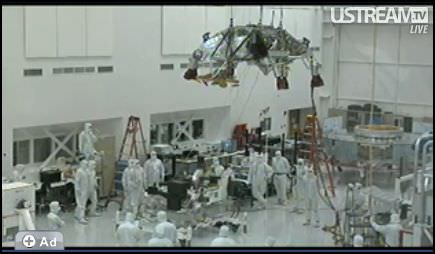
During the clean room tests on Tuesday, the Skycrane tethers were only deployed two-thirds of the way. During the actual landing on Mars, the tethers will roll out to about 7.5 meters (24 feet). Only three tethers will hold the big rover as it descends to the surface.
Gruel said after launch, landing is by far and away the biggest challenge of the mission. “We’re heading ballistically towards Mars, and when we hit the atmosphere we’ll have to burn off energy that energy and speed, get the parachutes to work, and then have the Skycrane do its job.”
Visible on the Skycrane are the thrusters that will keep it in the air as the rover descends.
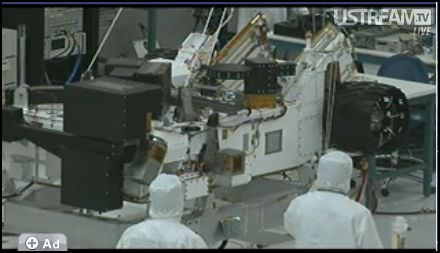
MSL is a huge rover. Gruel said it is the same size as a Mini Cooper car. Visible in this image is one of the rover’s wheels, and the Pathfinder rover that went to Mars in 1997 is about the same size as just of one of MSL’s wheels. This image below shows the comparisons between the different Mars rovers.
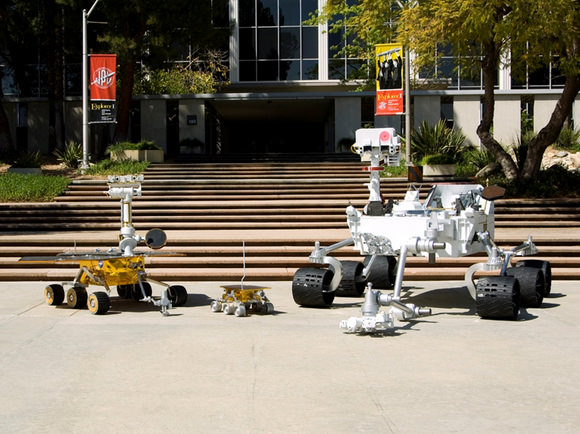
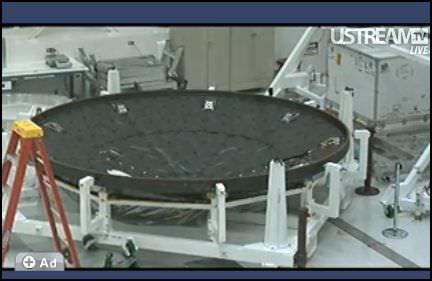
Here’s a shot of the heatshield and backshell for MSL, which are far bigger than the ones used for the Apollo capsules. The heatsheild pictured is a non-flight heat shield. The insulative material isn’t included on this version, which makes it easier to handle in the clean room.
Then after landing, the challenge will be to come up with interesting science, said Gruel, “just like we’re doing with Spirit and Opportunity, and try to continue to operate as long as possible.”
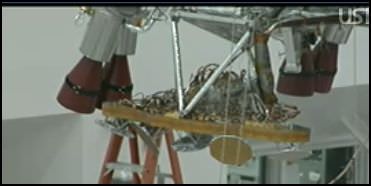
This is the Terminal Descent Radar and Imager, which will take images as the lander comes down through atmosphere. There are several other cameras on the rover, and Gruel said the cameras will have the ability to create “movies” by taking several pictures quickly in succession. “They won’t be like the latest action packed thriller, but we should be able to see what is like to traverse across surface of Mars,” said Gruel.
Vasavada answered questions in depth about the different scientific instruments on MSL.
“Not only will MSL be a robotic field geologist,” he said, “but it will have a mobile geochemistry laboratory, have the ability to drive up to a rock and sample it, take a scoop of soil, and take to instruments inside the rover to see what minerals are there, the chemistry and if there are any organics. MSL will have a Swiss Army Knife bag of tricks, giving us a virtual presence on Mars.”
“One instrument, Chem Cam has a high powered laser connected to a telescope,” Vasavada continued, “the laser points towards a target, and creates a spark. The instrument observes the spark and all the colors in the spectrum that comes back to see the chemical composition of rocks and soil.” This instrument doesn’t have to be up close to an object to study it, which will increase the areas of study. “There will be some places the rover can’t get to, like up a canyon wall, or down in crater, but this instrument can reach those areas,” Vasavada said.
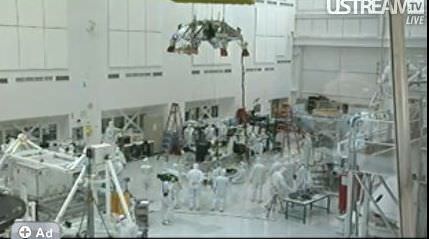
A weather station will be on the rover, supplied by scientists from Spain, studying wind, temperature, pressure, and relative humidity.
“We will attack Mars in a bunch of ways, to lend some more definitive answers to if there was liquid water, how long did it flow, how did the mineralogy work in Mars past, was it ever habitable, what were things like in the past and what are they like in the present, or was there any organics, and can we find evidence of past life. It’s a broad mission and everybody is really thrilled.”
A recording of the event is available on JPL’s USTream channel.

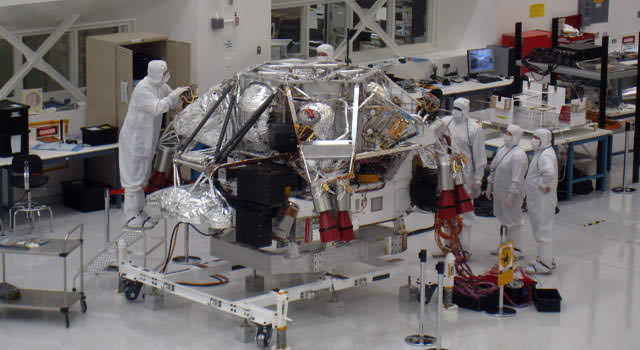
I’m always struck by just how hodge-podge it looks in these NASA clean rooms – (sometimes tiny) little rooms with a spacecraft shoved on a stand in the centre, stuff piled every which where around it. It looks like the labs at my work for God sake! Or my bedroom…
Don’t get me wrong – it’s awesome, but it just looks so… ordinary. I’m not sure what I actually expect it to look like, but this ain’t it!
Well Astrofiend, when you figure out what you expect it to look like can you please post a sketch?
Because I completely disagree with your first paragraph, period! Compared to the clean rooms I have to use at work (I am a Mission Systems Technician – not for NASA, and not in the US), the photos in the post appear clean, completely organised and functional, well equiped, bright, safe, and large enough to do ANYTHING in! So where the hell do YOU work then?
After all, NASA is a commercial business, not a flippin Hollywood movie set!!!!
“There will be some places the rover can’t get to, like up a canyon wall, or down in crater, but this instrument can reach those areas.”
That’s pretty cool. Can’t wait until MSL is on the red planet roving around.
I work for a particular division of a large research organisation in Australia. Sorry – I’d say more, but I don’t give out explicit personal information on the net.
I was more or less joking about the comparison to NASA – obviously their labs are well equipped, and fulfill NASA requirements in full. They just look so damn ordinary, especially those that are used for smaller missions.
I’m not sure really what I’m trying to say – perhaps just that they strike me as quite similar to my labs at work (though ours are not clean rooms), and in comparison to the mundane (though cutting edge) gauges that we come up with and put together here, NASA are making this very *un*-mundane stuff in a similar environment.
Goddamn I would sell my vital organs to work there though.
Astrofriend-I’d have to say the next generation Rover will have to look quite ordinary-my thinking is , the more ‘bells and whistles the MSL has , the more that can go wrong.
Because this is a much bigger vehicle than the Rovers on Mars, This new MSL will be a great test to see if it can do its’ expected missions dispite the size difference. If this new MSL can accomplish its missions, than the next generation Rover will be more complex using data from this MSL what problem areas it had on Mars and what contraptions worked good or bad and what
it had to do to get out of a bad situation(s)
I have quite a mess around my home 3 ‘destop ‘puters and servers,ext HDs, etc.etc.and more messy than my office when I retired 2 1/2 years as a Network Administrator, It’s a lot of fun thought. lol
Okay Astrofiend, this time I agree with you, last paragraph for sure! I’m an Aussie as well by the way.
Will there be any instruments on the crane or is it just completely abandoned after landing?